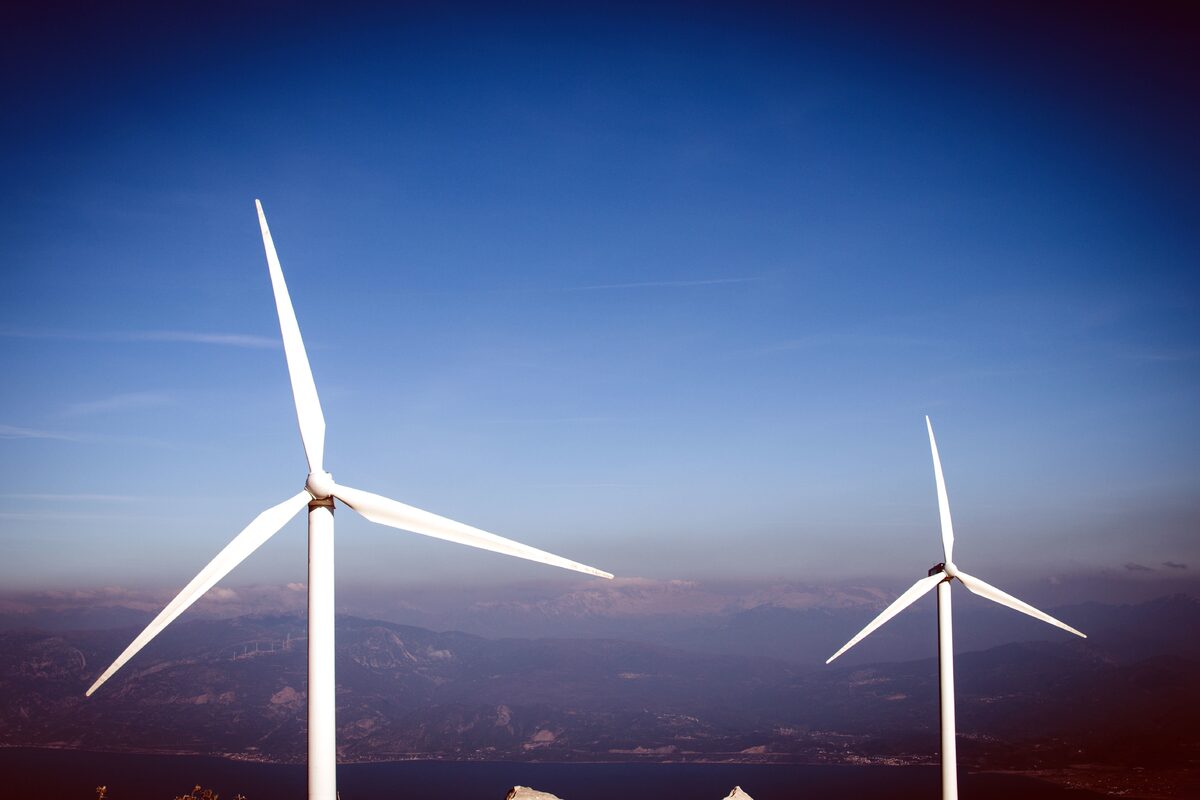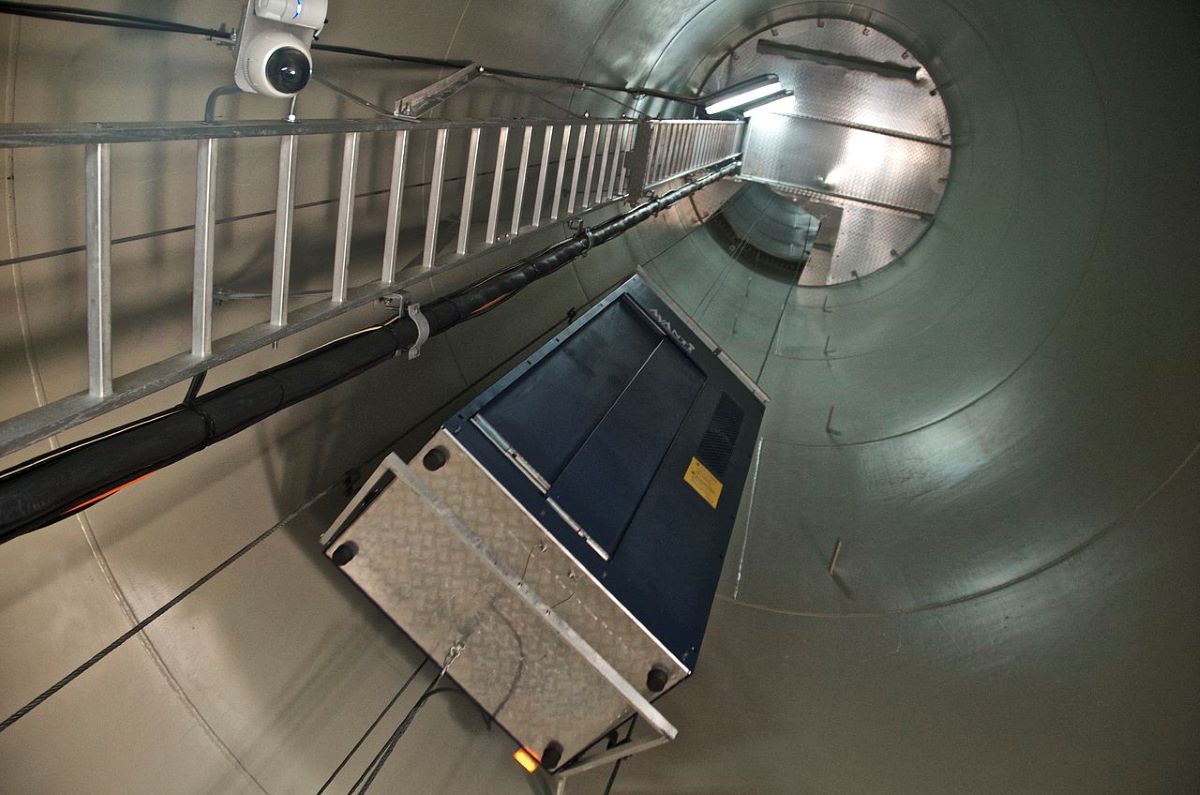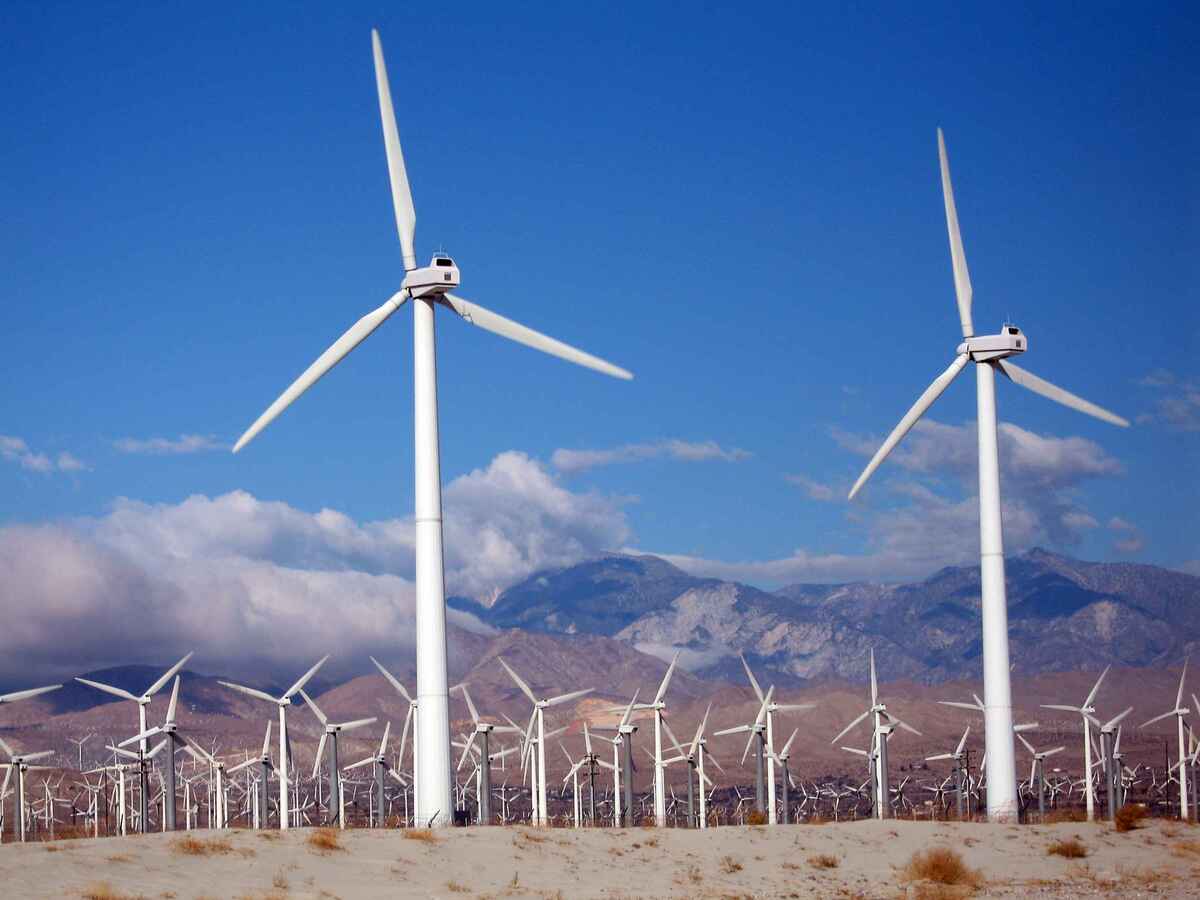
Un vertical wind turbine u horizontal is like an electric generator that works converting the kinetic energy of the wind in mechanical energy and through a wind turbine in electrical energy.
There are two main types of vertical and horizontal axis wind turbine. Those with a vertical axis stand out for not needing the orientation mechanism and what is the electric generator can be arranged on the ground. On the other hand, those with a horizontal axis are the most used and allow covering a wide range of isolated applications of small power up to installations in large wind farms.
We are going to delve into the two main ones, such as the aforementioned vertical and horizontal axis wind turbines, and what they would be new proposals that try to get the most out of it to the wind to produce electrical energy. We are in a few years where technology advances and we see new proposals every time such as the propellerless wind turbines of the Vortex project or that Wind Tree, a kind of mechanical tree that generates energy silently.
What is a vertical wind turbine?

A vertical axis wind turbine is essentially a wind turbine in which the rotor shaft is installed in a vertical position and can generate electricity no matter which direction the wind is coming from. The advantage of this type of vertical wind turbine is that can generate electricity even in places with little wind and urban areas where building regulations generally prohibit the installation of horizontal wind turbines.
As mentioned, vertical or vertical axis wind turbines no need for orientation mechanism and what would be the electric generator can be found located on the ground. His energy production is lower and it has some small handicaps like it needs to be motorized to get going.
There are three types of vertical wind turbines as are Savonius, Giromill and Darrrieus.
Savonius type
This is characterized by being formed by two semicircles displaced horizontally at a certain distance, through which the air travels, so it develops little power.
gyromil
It stands out for having a set of attached vertical blades with two bars on the vertical axis and offers an energy supply range from 10 to 20 Kw.
darrieus
Formed by two or three biconvex blades joined to the vertical axis at the bottom and top, it allows to take advantage of the wind within a wide speed band. The drawback is that they do not turn on by themselves and they need a Savonius rotor.
How does a vertical axis wind turbine work?
In vertical wind turbines, the blades rotate with the force that drives the wind. Vertical wind turbines, unlike horizontal ones, are always aligned with the wind. It does not matter which is the direction of the same since they can work even when the wind blows low speeds. The advantage of these vertical wind turbines is that they are smaller and lighter than the turbines that have the horizontal. Being smaller, they generate less energy. However, they are capable of heating a home, having all the interior and exterior lights on and recharging the battery of an electric car.
Horizontal axis wind turbines
Those with horizontal axis are The most used and they are the ones that we can find in those large wind farms where this type of wind turbines can be used above 1 Mw of power.
It is basically a rotational machine in which the movement is produced by the kinetic energy of the wind when it acts on a rotor that normally has three blades. The rotational movement produced is transmitted and multiplied by means of a speed multiplier to a generator that is responsible for producing electrical energy.
All these components they stand on a gondola It is placed on top of a support tower. They are the conventional ones that can be found in certain regions of our country drawing a different horizon and landscape but offering clean and cheap energy.
Each wind turbine has a microprocessor that is responsible for controlling and regulate its start-up, operation and shutdown variables. This takes all this information and data to the installation's control center. Each of these wind turbines incorporates, at the base of the tower, a cabinet with all the electrical components (automatic switches, current transformers, overvoltage protectors, etc.) that facilitate the transport of the electrical energy generated to the connection of network or consumption points.
The energy obtained from a wind turbine depends on the power of the wind that passes through the rotor and is directly proportional to the density of the air, the area swept by its blades and the speed of the wind.
The operation of a wind turbine is characterized by its power curve that indicates the range of wind speeds in which it can be operated and the power that is needed for each case.
What type of wind turbine is more efficient?
When it comes to energy efficiency, horizontal wind turbines are the ones that win the game. And it is that they are capable of reaching a higher rotation speed so they need a gearbox with a lower rotation multiplication ratio. In addition, because the construction of these wind turbines must be done quite high the increase in wind speed is used to a greater extent. In the upper layers of the atmosphere, the wind speed is higher since it does not have any type of obstacle.
What are the disadvantages of VAWT wind turbines?
The disadvantages of these types of wind turbines include the following:
- The initial cost of the installation is quite high.
- If you must in an area where there is not too much wind constantly, chances are that energy efficiency cannot be removed.
- You can have problems with neighbors due to noise.
- Turbines usually only operate at a capacity of approximately 30%.
Use of wind turbines and history
The use of electrical energy from the wind has already been used with wind rotors in isolated houses located in rural areas in the mid-XNUMXth century.
But the one that really bet on this technology in the 70s was Denmark. This fact allowed this country to be one of the leading manufacturers of this type of wind turbine, as is the case with Vestas and Siemens Wind Power.
Already in 2013, wind energy produced the equivalent of 33% of total electricity consumption, with 39% in 2014. Now Denmark's goal is to reach 50% by 2020 and by 2035 84%.
The change that this country produced was due to high CO2 emissions in the late 70s, so renewable energy became the main choice for this country. This led to a decrease in energy dependence on other countries and a reduction in global pollution.
Historic was the installation in Denmark of the first wind turbine that reached 2 MW. The power plant had a tubular tower and three blades. It was built by teachers and students from the Tvind school. And the funny thing about this story is that those "amateurs" were ridiculed in their day before the inauguration. To this day that turbine still works and has a design very similar to the most modern wind turbines.
The future of wind turbines
To this day, technological innovations continue to emerge to improve applications of wind energy. In 2015, the largest installed turbine was the Vestas V164 for use near the coast.
In 2014, more than 240.000 wind turbines they were operational in the world, producing 4% of the world's electricity. In 2014, the total capacity passed 336 Gw with China, the United States, Germany, Spain and Italy as the leaders in installations.
And it is not only these countries that are growing their population of vertical or horizontal axis wind turbines, but many others that they look for a way to be more sustainable As is the case in France with the Eiffel Tower, which now generates its own energy thanks to newly installed wind turbines and to which LED lights, solar panels and a rainwater collection system will be added to promote clean and cheap energy. .
Nor can we forget about new attempts in the form of 157 wind turbines for 3 new wind farms in South Africa that will come from the hand of one of the largest manufacturers of this type of technology such as Siemens. They will add between the 3 a capacity of 140 mW and it is expected that they will be installed by the beginning of 2016 to provide electricity to the nearby populations of this African country.

The technology of floating wind turbines
As we could see in the history of wind energy, offshore wind energy started to expand in 2009 when the Hywind floating wind turbine was installed in Norway at a cost of close to 62 million dollars.
Japan, after the Fukushima nuclear disaster, has devised the installation of 80 marine wind turbines on the nearby shoreline by 2020.
Vortex Propellerless Wind Turbines
A Spanish company called Deutecno has created a wind turbine without moving parts which won first prize in the Energy category at The South Summit 2014.
These propellerless wind turbines are they would be in charge of eliminating those huge wind turbines that modify the horizon wherever they are installed. Its functionality will be similar but with quite significant cost savings, apart from the fact that its maintenance and installation are cheaper.
There must also be a reduction in environmental impact apart from that it eliminates the noise that traditional wind turbines generate.
Their technology works in such a way that uses deformation caused by vibration which is caused by the wind when entering into resonance in a semi-rigid vertical cylinder and anchored in the ground.
The main part of Vortex, which is the cylinder, has been made of piezoelectric materials and fiberglass or carbon, and electrical energy is generated by the deformation of these materials.
2016 will be the year in which the first bladeless windmill unit is ready.
Wind tree
A fairly innovative project is the Wind Tree that is being developed by NewWind and that is composed of 72 artificial leaves. Each of them is a vertical turbine with a conical shape and has a small mass that can generate power with a light breeze of 2 meters per second.
This allows you generate power for 280 days in the year and its total production is 3.1 kW with 72 turbines running. 11 meters high and 8 meters in diameter, the Wind Tree is close to the size of a real tree so it can fit perfectly in that urban space.
Un quite particular project and that puts us before those technological advances that seek the way to be more efficient and to be able to provide enough energy to the public electricity grid or as an extra for a building.
Parts of a wind turbine

Image - Wikimedia / Enrique Dans
Wind turbines as a whole they can measure up to 200 meters in height and 20 tons of weight. Its structure and components are complex and are manufactured to optimize power generation from the speed of XNUMX to the maximum.
Between the components and parts of a wind turbiner we have:
La base
The basics for a wind turbine is to be well attached to a strong base. For this, horizontal axis wind turbines are built with an underground reinforced concrete foundation that adapts to the terrain in which it is located and helps to withstand wind loads.
Tower
The tower is the part of the wind turbine that supports all the weight and is what keeps the blades off the ground. It is built of reinforced concrete at the bottom and steel at the top. It is normally hollow to allow access to the gondola. The tower is in charge of raising the wind turbine enough so that it can take advantage of the maximum possible wind speeds. A steel or fiberglass rotating nacelle is attached to the end of the tower.
Blades and rotor
Today's turbines are made up of three blades as it provides greater smoothness in the turn. The blades are made of a polyester composite material with a reinforcement of glass or carbon fibers. These compounds give the blades greater resistance. The blades can be up to 100 meters long and are connected to the rotor hub. Thanks to this hub, the blades can change the angle of incidence of the blades to take advantage of the wind.
Regarding the rotors, at present are horizontal and may have joints. Normally, this is located to the windward side of the tower. This is done in order to reduce the cyclical loads on the blades that appear if it is located to leeward of it, since if a blade is placed behind the wake of the tower, the incident speed will be greatly altered.
The gondola
It is a cubicle that you could say that It is the engine room of the wind turbine. The nacelle revolves around the tower to position the turbine facing the wind. The nacelle contains the gearbox, main shaft, control systems, generator, brakes, and turning mechanisms.
Gearbox
The function of the gearbox is to adjust the turning speed from the main shaft to the one needed by the generator.
Generator
In today's wind turbines there are three types of turbines that vary only by the behavior of the generator when it is in conditions of excessive wind speed and attempts are made to avoid overloads.
Almost all turbines use one of these 3 systems:
- Squirrel Cage Induction Generator
- Biphasic induction generator
- Synchronous generator
Break system
Braking system it is a security system It has discs that help in emergency or maintenance situations stop the mill and prevent damage to the structures.
Control system
The windmill is fully controlled and automated by the control system. This system is made up of computers that manage the information provided by the wind vane and the anemometer placed on top of the nacelle. In this way, knowing the weather conditions, the mill and blades can be better oriented to optimize power generation with the blowing wind. All the information they receive about the status of the turbine can be sent remotely to a central server and have everything under control. In the event that wind speeds or weather conditions can damage the structure of the wind turbine, with the control system you can quickly know the situation and activate the braking system, thus avoiding damage.
Thanks to all these parts of the wind turbine you can generate electrical energy from the wind in a renewable and non-polluting way for the environment.

We have an electric generation project. I need contacts to start up. Phone 57830415_7383284 Thank you very much
I want to find a wind turbine for home that can produce 24kwh per day for a personal project and that can indicate costs, thank you
Hi Javier .. from your query I see that you need 1 kilowatt hour… I offer you the best price and quality in the market
for this I need your background such as city, country, etc.
HELLO I AM AT THE START OF THIS PROJECT ALREADY WITH VERY PROMISING RESULTS ALREADY TESTED AND LOW COST MY MAIL a_eletropaucar@hotmail.com peru
These behemoths of generators have a very short route, because it is just around the corner, the generation of electricity by magnetic magnetic currents (magnets) and all homes will be able to have their own generator, of 4 or 5 kw in a space similar to that of a washing machine.
Greetings, I want more information to implement your solution in a residential building, we want to reduce and / or eliminate consumption; we have electric heater for the pool and the lighting of all common areas, please send complete technical information about vertical generators.